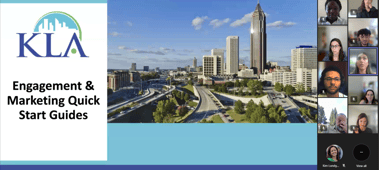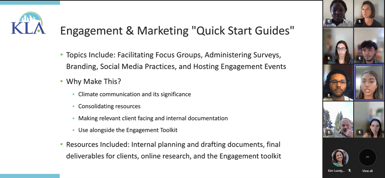.png?width=436&height=352&name=MicrosoftTeams-image%20(31).png)

Guest Post by Saahithi Achanta, KLA Summer 2023 Marketing & Engagement Intern.
Saahithi is a rising senior at Boston University studying Environmental Policy and Analysis.
My summer as KLA's Marketing and Engagement Intern exposed me to three top strategies for driving behavior change as we fight the climate crisis, including the value of storytelling, the importance of knowing your audience, and the critical role of effective communication tactics in planning.
Applying what I learned in environmental policy classes to real deliverables that would be used as public or internal resources was a shift in the work I’ve done academically, but helped me realize the niche of climate communication. Through my internship, I’ve been utilizing climate communication as a tool to bring attention and drive interest in climate action on behalf of KLA. I find relevance in climate communication through day-to-day tasks such as annotating survey results and deducing reactions to climate policy, by drafting social media posts, and sitting in on branding calls with partners.


Images from Saahithi's final intern project presentation to KLA Staff
Through all of these various activities, a pattern of best practices became apparent on ways to project the importance of climate action and ways to induce positive behavior change. A highlight of my internship was meeting different clientele from around the US, and seeing how perceptions, policy, and implementation for sustainability differed depending on the audience. These are the top three strategies I learned through my internship with KLA:
1. Stories Over Statistics
During this internship I’ve had to navigate the difference between writing reports academically, and in a way that will reach people in real- world implementation. Learning how to most effectively address residents of small towns or large cities was a valuable skill for any future endeavors. The biggest lesson of all is that stories will always get through to people more effectively than statistics. As a student who values science and statistical defense, it was interesting to see how moving climate stories can be and how personable approaches to climate policy seem less intimidating than those enforced through numbers and reports. Whether you’re attempting to reach people in a rural suburb or in a coastal city, both parties can empathize with a story of another human with whom they can find common ground. Frontline communities — those that experience the “first and worst” consequences of climate change — have a valuable perspective on climate change and its real-life implications, which are powerful to share when much of the country is not aware what a future impaired by climate change can look like if sustainability measures are not taken.
2. Climate Action is Never the Same
Something that struck me about KLA was how personable every Climate Action Plan, every branding session, and all resources are to fit the town or city KLA works with. Every survey template or presentation was done with careful consideration of the audience and what their existing relationship with climate change may look like. As I started working on diverse client projects, I realized why this consideration was taken. Every town has a different relationship with sustainability, people’s values shift so drastically from Nevada to California and North Carolina to New England. Depending on regional climate, existing policy, and the values of residents, climate action must be considerate of external factors. For example, access to water perhaps is not a focus for a Climate Action Plan developed in coastal areas, but it can be for landlocked states. Different types of renewable energies can be favored depending on tree canopy, weather, when houses were built, and transportation needs. By targeting the real-life struggles, experiences and desires of residents and hearing it directly through them will guide climate policy like no other.
3. Communications Make or Break Climate Action
In career fairs about environmental consulting, Marketing and Engagement were touched on as parts of the implementation process for climate policy, but I never realized how nuanced and pivotal these practices are to ensure that sustainability action remains relevant. Every aspect of climate policy is incredibly important and irreplaceable; from variable tracking, climate analysis, plan development, branding, advertising, and gauging activity afterwards. But working in communication has made me realize the unsung heroes of climate action are those who help make the hard facts and nuanced reports understandable to those who are not regularly surrounded by sustainability resources.
Climate policy can go over the heads or get lost in the busy lives of millions of Americans if people are not prepared to understand what sustainability brings, how it affects them, and how communities could accommodate a lifestyle that would bring them more utility in the long-term future. Without an adequate brand with eye-catching graphics or enticing headlines, who will look at the advertisement directing them to the City’s links for clean energy subsidies? If pamphlets are not printed in different languages and distributed evenly around municipalities, will frontline communities be able to take advantage of the state’s programs? Even the best climate action plan cannot drive real change unless it is communicated effectively.
This list only scratches the surface of the real-world skills I’ve learned in my internship with KLA, and I am so humbled to be a part of a brilliant and supportive team. I’ve learned so much about myself and skills that I developed, but more importantly I learned about environmental consulting and the influential power of communication. Behavior change towards sustainability is difficult to foster, but hardworking groups like KLA strive to make the world a better place. This gives me more confidence about our future and how we can all play a part in making strides towards a greener future.
--
Read our other 2023 KLA Summer Interns' blogs here:
Nathan Abreu-Cruz, Climate Analysis Intern: Choosing Climate Metrics that Matter
Dunia Seidu, Climate Storytelling Intern: Cambridge Leads Building Decarbonization with BlocPower Partnership


